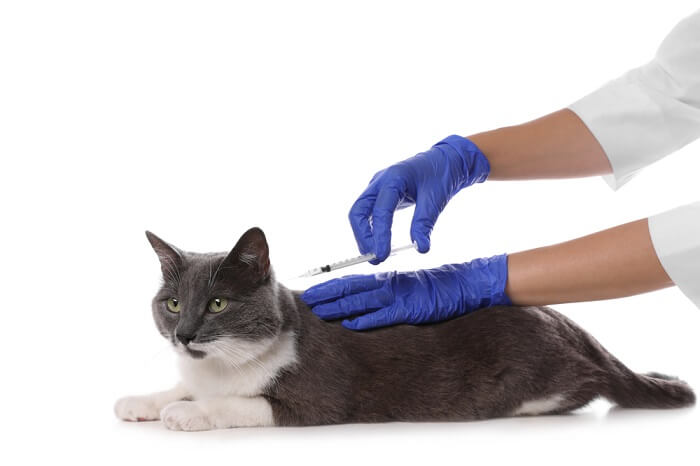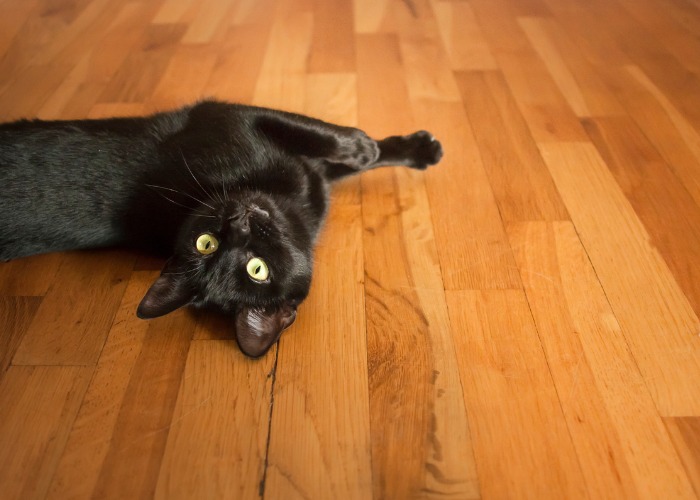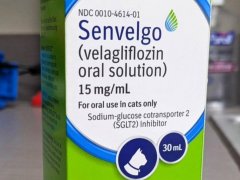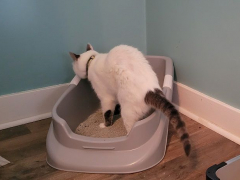Cerenia is the brand name for a drug called maropitant, or to use its full name, maropitant citrate. Maropitant is a neurokinin-1 (NK1) receptor antagonist which was developed by Zoetis (formerly Pfizer) specifically for the treatment of motion sickness and vomiting in dogs.
Cerenia for Cats Overview

Injection: 10 mg/ml
It was approved by the FDA in the United States in 2007 for use in dogs, then in 2012 for cats. Cerenia is now widely used for cats in veterinary clinics around the world.
How Cerenia Works
The primary use of Cerenia for cats is as an anti-emetic i.e. to stop nausea and vomiting. It works by intervening with the vomiting process in the brain.
Vomiting is normally prompted when impulses from the chemoreceptor trigger zone (CRTZ) in the brain are sent to the vomiting center in another part of the brain known as the medulla.
Cerenia suppresses these impulses so that vomiting is no longer prompted.
More specifically, Cerenia is a neurokinin-1 (NK1) receptor antagonist that stops substance P from binding to NK1 receptors. NK1 receptors are intimately involved in the initiation of vomiting. As well as in the chemoreceptor trigger zone (CRTZ) and the vomiting centre in the brain, they are found in the vagus nerve (close to the digestive tract).
Substance P is the key neurotransmitter involved in vomiting, and it’s found at all three of these locations. Cerenia has a similar structure to Substance P, allowing it to bind to the NK1 receptors in the same way as Substance P, but without causing the same stimulation.
It’s the ubiquity of the action of Cerenia—at three different sites from the digestive tract to the brain—that makes it so effective as an anti-emetic.
Uses of Cerenia for Cats

Here are a few of the most popular uses of Cerenia for cats:
- Cerenia is primarily used to control nausea and vomiting in cats, including motion sickness.
- One specific long term use is to prevent vomiting in cats with renal failure.
- Veterinarians often use Cerenia to treat acute vomiting episodes.
- Cerenia can also be used as a mild form of pain relief. It is sometimes used in surgery, reducing the pain felt during manipulation of internal organs during procedures such as spaying, and hence reducing the amount of general anaesthetic agent needed (this is known as an “anaesthetic sparing effect”).
- Finally, Cerenia has been found to help to prevent itchiness in cats with non-flea, non-food-induced hypersensitivity dermatitis.
How It’s Administered?

Cerenia Injections for Cats
Cerenia is usually given to cats in the injectable form a dose of 1 mg/kg body weight (1 ml/10 kg body weight) as a subcutaneously administered (given under the skin) injection, but it can also be given as an intravenous injection. Drug administration can continue once daily for up to five days.
Cerenia Tablets for Cats
Cerenia tablets are also available, formulated for oral use in dogs. Although Cerenia tablets aren’t licensed to be given to cats, some veterinary texts advise that off-label use is appropriate for certain selected cases. Cerenia should only be given to cats in this way when recommended by the consulting veterinarian.
Side Effects of Cerenia for Cats
The principal adverse reaction is pain and/or vocalization which is reported in around one in three cats when Cerenia is injected. This may last up to a few minutes but passes without the need for treatment. If Cerenia injectable is refrigerated before the injection is given, this pain reaction may be lessened compared to administration at room temperature.
There are a few other common side effects.
Product information sources mention that rarer side effects after the injectable solution is given include fever/pyrexia, dehydration, lethargy, anorexia, hematuria, hypersalivation (drooling) and injection site swelling, but each of these only happens in less than 1-2% of cases.
As with all products, an unexpected allergic reaction is also possible.
Some owners may experience allergic skin reactions themselves due to topical exposure to the drug after handling tablets, perhaps associated with skin sensitization, so it’s advised that people should wash their hands after administering tablets to their pets.
Drug Interactions
Cerenia is a protein-bound drug, and its use at the same time as other protein-bound drugs has not been studied. Such drugs include NSAIDs, cardiac and anticonvulsant medications. For this reason, cats that are being given such medications concurrently should be monitored particularly closely.
Risk Factors

The use of Cerenia has not been studied in pregnant or lactating cats and it should not be used in kittens under sixteen weeks of age.
Cerenia must only be used in specific, appropriate situations with close attention to prescribing information. Safe use of Cerenia has not been assessed in cases of vomiting where the underlying cause is gastro-intestinal obstruction or ingestion of toxins.
Veterinarians may be concerned about the risk that the medication could mask clinical signs, creating an illusion that such a patient is recovering because the key sign of vomiting has been suppressed, when in fact there is still an ongoing problem.
For this reason, it is common for vets to advise abdominal x-rays and/or bloodwork to evaluate the presence and severity of any underlying conditions or GI obstructions before treating with Cerenia.
Cerenia should be used with care in cats that are suffering from hepatic dysfunction (liver disease), as the drug is metabolised by the liver. Vets may recommend a reduction in dose by 25-50% for such patients.
Conclusion
Cerenia (maropitant) is a useful addition to the veterinary pharmacy for the prevention of acute vomiting, or to help cats who are feeling nauseous or are suffering from vomiting due to certain causes. It is a highly potent medication that’s very safe, but it needs to be used in the correct situations.
Drug Dosing Disclaimer: We are only able to provide doses for medications that are FDA approved for use in cats and only as the label guidelines dictate. For medications that are used off-label we can only provide guidelines and safety information for use. Safe and appropriate dosing for off-label medications can only be determined by a primary care veterinarian.
We encourage you to work with your veterinarian to determine if a particular medication is appropriate for your cat. Changing or adjusting a dose for your cat on your own without consulting with a veterinarian can carry risk. We do not encourage use of medications prescribed for human use in pets without first consulting with a primary care veterinarian.
Frequently Asked Questions
Will Cerenia stop my cat from vomiting?
Cerenia is a prescription-only anti-emetic. It has to be prescribed by a veterinary professional, rather than a medication to be selected by pet owners. The drug is not suitable for every case of vomiting in cats, so the choice of the product as a way of treating any individual case is always a decision for the veterinarian treating a particular animal.
Will Cerenia help a cat that's suffering from weight loss?
There are many possible causes of weight loss, and while Cerenia may help some cats that are losing weight partly caused by repeated vomiting, it may not be appropriate for other cases. This is why Cerenia must only be given when recommended by a veterinarian.
Is Cerenia safe for cats?
Cerenia is a safe product, with the only common problem being the transient pain reaction that can happen when the injection is given.
When cats were given up to five times the recommended dosage doses daily for fifteen consecutive days, there were no discernible adverse effects either clinically (the animals seemed well) nor in laboratory tests (using blood and urine samples).
How long does it take for Cerenia to take effect?
The drug works rapidly, reaching its full effect within 30 minutes to two hours.
What if I miss a dose?
As a once-daily product, if a dose is missed, the normal dose should simply be given the following day at the normal time. There is no need to give a higher dose.
Does Cerenia make cats sleepy?
Sleepiness is a rare side effect. Less than one in fifty cats may experience some lethargy, sleepiness or loss of appetite.
Where can you buy Cerenia for cats?
Cerenia is a prescription-only medication, meaning that it can only be obtained through veterinarians, on their recommendation for a particular case.









My cat has frequent cystitis due to bladder nerve damage following fractured pelvis. Her tail hangs limp she has oops moments leaving puddles. She sleeps on puppy pads. As soon as the oops moments increase( change to usual pattern) I dip her urine & manage to get sample to vets & she commences antibiotics for a week. She’s has this every 8-12 wks I saw lady posted on social media her cat has nerve damage too & lots of cystitis & her boy has this daily. This lead me to do search found this site but don’t see mention of cystitis just looking for any advice. My girl is fit & well no stones grit kidney or any other issues she drinks plenty of water & has wet food thanks 😻her bladder nerve damage was as a result of being used as foot ball sustaining fractures. She had intensive physio is fully mobile
Hi Michelle,
Please post your question on our health forum:
https://cats.com/community/health-care
And Dr. Chris Vanderhoof, will reply to you directly on that thread
I don’t see the usage listed, but my vet prescribed Cerenia for my cat to reduce coughing from asthma. Since he won’t accept tablets, I crush a quarter tablet into his food each day. It has the welcome side effect (in this case) of reducing vomiting.
HI I am looking for advice as to whether I can give my cat lactulose for constipation while she is taking Cerenia? ( she is on Cerenia 5 day trial of 8 mg daily , then dropping back to 8mg every second day for 5 days to treat her ongoing vomiting)
Please help
There is no contraindication to giving lactulose at the same time as cerenia, but this decision is really one for your veterinarian to make, based on the full background to your cat’s condition. What is the precise diagnosis here? Why is she vomiting? These are really important questions you should be discussing with your vet.
Thank you for getting back so quickly! Seeing my Vet for around 12 months in relation to her vomitting which does not respond to Cortisone treatment, but does respond to a course of Metronidazole. We are trying the Cerenia to see if the anti-inflammatory effects will help settle her. They have not been able to find the cause of the vomitting as yet ( we have yet to have endoscopy / biopsy- she is still very young at only 18 months old.. she is prone to constipation and is not a big drinker of water ( I add water to her food) I just wanted to give her some Lactulose to prevent the constipation worsening. I will speak to my vet again in the morning, but in the mean time wondered if I could give her a dose of lactulose tonight to start thing moving. I appreciate any insight you might have.
In general, lactulose is a safe product in small doses, as it simply draws fluid into the lower bowel, making dry-packed feces more moist and hydrated. So yes, you can do what you suggest. RE the vomiting, I am sure you have tried exclusion-type diets, have you? Have you read this article? https://cats.com/food-allergies-in-cats
Thank you so much! Yes have tried exclusion diets, she is currently on Science Diet ZD – hydrolysed protein as initial thoughts were this may be food sensitivity or allergy. she also has Royal Canon Analergenic dry food ( in small quantities) as it exacerbates the constipation. It is a slow and frustrating process, but my only concern is that she has some quality of life without vomiting or feeling unwell. Again I am so very grateful for your advice I will give her 1 ml – Lactulose now to try to avoid enema’s and the like!!
You are so very kind to reply to my questions. It is very much appreciated.
Kind Regards
Margot
(Australia!)
My 15 year old cat has been prescribed Cerenia suspension for vomiting. It is helping a lot1 She is interacting with the people in the house, exploring rooms she doesn’t usually go in to and gaining some weight back. She is eating and drinking much better.
So what is the question, you might ask..The suspension is $46.50 USD for 1 oz! I am retired on disability. I am being forced to let my cat die or kill her (because she throws up all the time) my cat because I can’t afford the cost!
Is there a program for people like me who need help with pet medication?
Is there a similar over the counter medication that I could substitute?
Please help!
You didn’t mention why your cat has been vomiting. Is there any way you can address the underlying cause to get rid of the vomiting once and for all? Vomiting from IBD, kidney disease, and other common health issues can all be addressed in a way that should eliminate the need to use Cerenia. Other than that, there are a few foundations created to help low-income people care for their pets. Here’s a list of several options. If you feel comfortable doing so, you may want to ask your veterinarian for advice as well. Hope this helps!
How long does an injection of Cerennia last?
The anti-emetic effect of Cerenia persists for 24 hours after one injection.
My 15 year old cat has lymphoma which leads to bouts of nausea and vomiting. Cerenia has been a blessing and gives him his appetite back almost immediately. I am just concerned that the more I use it on him, the less effective it will be. Right now, he only needs it every week or two when his vomiting lasts more than once or twice in a day. Can it be used more frequently to control his nausea without him building up a resistance to the efficacy of the treatment?
Maropitant works by inhibiting the binding of substance P in the emetic (vomiting) center of the brain, resulting in anti-vomiting effects. One injection lasts 24 hours in cats, and it is only licensed for use up to five days in a row. It isn’t licensed for continual use longer than this, which is probably why intermittent use as your cat is being given is more likely to be recommended. The main aim is to use a product like this safely, and so caution is needed not to over-use it, even if there are no known specific issues (such as resistance). Reading from what other vets have suggested elsewhere, alternate day use (every second day) has sometimes been used safely, and even ongoing daily use for some conditions. However this is a prescription only product, so its use should be carefully monitored by your veterinarian, and you should follow their advice. I hope these thoughts at least give you some background information that may help.
My cat got a shot of covenia and cerenia. Does this affects her using the bathroom. Haven’t use it in 2 days. Pee a little bit but no bowel movement
Hi Eduardo, constipation and not urinating aren’t typical side effects of either Cerenia or Convenia, so I would contact your veterinarian.
1/2 tab Cerenia once a day x 4 days caused heavy drooling in our 12 year old cat with pancreatitis. Very upsetting for her & for us.
As she is now on RX GI wet food, I am hoping the pancreatitis and vomiting will stop so we won’t have to continue the Cerenia.
What else can be given for vomiting if needed in the future?
The main issue is to address the primary cause of your cat’s problem: the cerenia blocks the vomiting, but the ideal answer is to address the original cause of the vomiting. This is difficult with pancreatitis, but the type of answer means an ultra low fat food (fat prompts inflammation of the pancreas), plus plenty of oral fluids (consider a cat fountain to encourage drinking). Please read our article about pancreatitis here https://cats.com/pancreatitis-in-cats. If vomiting continues despite these changes, then do talk to your vet about other possible anti-emetics available on prescription only.
My 10 yr old cat, Mister has been preliminarily diagnosed with an upper GI issue after an ultrasound and blood tests. His results from a GI panel is not available yet. Over the course of 3 months he’s lost 4 lbs. due to vomiting. He doesn’t like to eat because it makes him feel sick. A month ago the vet put him on prednisolone but this didn’t improve his appetite at all. 2 days ago the vet finally gave him an injection of cerenia and some mirataz in his ear. This seemed to help him start to eat again. The vet sent me home with a prescription of 16 mg cerenia and mirataz. Is it ok to split the cerenia in half and mix in with his food or do I have to give him the whole 16 mg pill? Thank you for your help.
This is really a question you should put to your veterinarian, and this is a prescription only product, and your vet will know more about the specific details of the case, your cat’s precise body weight etc. But in general, this medication is designed to be given once daily, and tablets are breakable along the score line on the tablet. If the dose is 16mg per day, therefore, you could give one whole tablet, or you could split the tablet into two halves, but the idea would be that these should be given fairly promptly one after the other, rather than several hours apart. Hope this helps.
My 5 year old cat started vomiting out of no where and I took her to the vet where they administered a cerenia shot. They also have given me prescribed wet food, that she didn’t want to eat, so i started giving her a finger full every four hours and syringe feeding her water. It has been three days and she isn’t eating on her own or drinking water. What do I do?
Hi Veronica and thanks for your comment. After this long, a cat’s normal appetite really ought to have returned, and she should be eating on her own by now. So I would strongly recommend that you take her back to your veterinarian for a review, so that they can re-examine her. If the cause of the problem is not obvious at this stage, they may need to carry out further investigations to find out precisely what’s up with her.
my cat is 12yrs old taken her to the vet for being sick too much ,was given cerinia injection seam to work and was given 16mg cerirenia tablets to be given twice a day after the the 2nd tablets her health deteriated taken back to vet and was told the same night after being kept in that her health had got worse could this be a side affect of the drug we dont know if she will make it and recover …could this be down to the drug.
As you can see from the article, Cerenia blocks the vomiting reflex, so it is very good at stopping cats from vomiting in the short term. But often there is an underlying reason for the vomiting, and Cerenia does not fix that problem. So you should talk to your vet about the possible causes of the vomiting. Cerenia is very unlikely to make her deteriorate as a side effect while it is very likely that the underlying cause of the vomiting is now having other impacts, and that is why she is deteriorating. Hope this helps. Pete
Our 11 year old cat had a second dose of Cerenia tonight (a quarter tablet). Almost immediately he was very ill – didn’t think he was going to make it but he has pulled through – so far. Will see how it goes but no more Cerenia for us, Interesting that it was second dose for your cat too. Did your pet pull through?
Are gabapentin and cerenia contraindicated? Both are tablets.
These drugs should only be given under close veterinary supervision, so this is a question that you really ought to direct to the DVM veterinarian who is treating your cat. That said, to my knowledge, there are no specific suggestions of any adverse interaction between these two drugs. Hope this helps. Pete
Thank you for the response! The medications were prescribed by my cats veterinarian for when we need to travel with my cat. He gets very car sick and unhappy. I just wanted to get a second opinion on potential issues of these medications are combined. I appreciate your opinion! 😃
My five year old cat has bouts of pancreatitis. Today was her first flare up in a couple of years. I gave her 8 mg of Cerenia. Now she’s purring and hungry. How long do I have to wait to feed her to insure she doesn’t throw up the tablet?
Cerenia is a prescription-only product, meaning that it has to be used under direct veterinary supervision, so the best answer here is that you talk directly to the veterinarian who prescribed the medication, as they will have a clear understanding of the details of your cat’s issue.
With best wishes
Pete
I have to give my 16 year old stage 3 CKD cat cerenia occasionally for vomiting due to the CKD. I only give him 1/4 of a 16 mg tablet and only when he throws up due to nausea. I put the remainder of the Cerenia that is cut up into 4 pieces back into the blister container that it came in. I read though that once the blister packet has been opened that the Cerenia is only effective for 24 hours after opening. Is this correct? I am just wondering because my cat only takes Cerenia when he is vomitting due to nausea which is not every day. There could be a week or more between when he needs another 1/4 tablet for his vomiting. Does this mean that if my kitty doesn’t need another dose of Cerenia in 24 hours, I have to throw the rest of the cerenia away as it is no longer effective? Please let me know. This will get very expensive if that’s the case!
It’s common as a general rule for statements like this to be made about medications, since once a tablet has been removed from its initial storage, there is a general risk of exposure to air to cause some degradation of the contents (think about a bottle of milk once it has been opened). That said, I cannot find anything specific like this for cerenia (maropitant) and my sense is that it is reasonably stable as long as you are sensible (store it at room temperature). If you are concerned, you might wrap the remainder of the tablet in a small piece of cling film (plastic wrap) to seal it from the surrounding atmosphere. I hope this helps a bit.
Hi Shar – you certainly have been impressively proactive with your management of your cat.
Re: your specific questions:
+++
I’ve just ordered a compounded trans-dermal gel version of the drug. One would think that would be the standard for a nauseated dog or cat. Why wouldn’t it be the common means of admin?
Is there any contraindication for giving this in that form?
I’d like to hear any experience you may have with cats/maropitant/transdermal lipid based gels.
+++
This is an interesting area. Transdermal medication has not really been fully developed by drug manufacturers to date and is more often used as one-offs, by having products specially compounded as you have done.
Other examples that have been looked at in the past 20 years are listed below:
Amitriptyline, Amlodipine, Atenolol, Buspirone, Cyclosporine, Dexamethasone, Enrofloxacin, Fluoxetine, Glipizide,
Methimazole, Mirtazapine, Ondansetron, Phenobarbital.
However, in many cases, the results of the studies have not been satisfactory, with variable absorption and lack of consistent results, which is why this is not used widely commercially.
Methimazole (for hyperthyroidism) seems to be one of the few drugs with strong evidence to support its efficacy.
There are also potential issues for owners, with medication perhaps being absorbed by human contact with the medication or with the cat itself, leading to concerns.
Irritation at the site of application is a common problem, as well as cats interfering with the product.
The general understanding in the veterinary world is that due to the variability of effectiveness, as well as the lack of documented evidence of efficacy, other routes for giving medication are generally tried first. Even when compounding medication for individual patients, vets tend to prefer to put medication into liquid or treat formulations as the oral route has been studied far more, so is seen as more effective, safer and more reliable.
I hope this helps. Pete
Hello –
This is really a success story, followed by a question.
Success story:
12 years ago, I adopted a feral cat who (amazingly) has finally socialized and become quite the affectionate lap cat.
He’s generally very healthy, but with occasional bouts (sometimes years apart, sometimes months) of pancreatitis (idiopathic). If symptoms aren’t addressed quickly, he’ll dehydrate and start going down hill very fast, resulting in 1 day of constant vomiting, followed by 3 or 4 days of not eating or drinking + pretty scary lethargy and depression. My goal regarding this was to have everything at home I needed to treat this as quickly as possible (with careful consideration that vomiting, for example, could be caused by something else).
I asked my vet about trying a combo of Cerenia and low dose Gabapentin. She agreed that this was reasonable and we tried it. I kept these on hand – and it has been miraculous in making these flare-ups of much shorter duration. After some reading, my understanding is that Cerenia by itself appears to have some anti-inflammatory properties when given to cats. I imagine that’s a pretty good bonus when dealing with idiopathic pancreatitis.
The question:
I’ve just ordered a compounded trans-dermal gel version of the drug. One would think that would be the standard for a nauseated dog or cat. Why wouldn’t it be the common means of admin?
Is there any contraindication for giving this in that form?
I’d like to hear any experience you may have with cats/maropitant/transdermal lipid based gels.
Thanks,
– Shar
Hi Shar, thank you for commenting, and apologies for the late response! This is a bit out of my territory as a non-vet, but I will pass your message along to Dr. Wedderburn, and he may be able to answer your question about the transdermal gel version of this drug. Cheers, Mallory
My Vet gave me Cerenia to give my 17 year old cat because he has been sneezing blood, and she can not find out why. Also taking thyroid meds and prednisone. only taking a quarter of a cerenia on Monday, Wednesday, Friday only
This is very logical use of the product: this covers the possibility that your elderly cat has an active bacterial infection that’s causing at least some of the signs of illness that you are seeing. In an ideal world, you might get CT scans, MRI scans, endoscopy done to try to learn more about the cause of sneezing; in the real world, this is not always possible, so it’s common for vets to take an approach of ruling out causes by using therapy (eg giving convenia to rule out a bacterial infection). Good luck with your old friend.
My vet prescribed Cerenia compounded into a ear gel or cream to treat itchiness and scratching of the eye lids, face and ears. My cat is 15 years old , Her heart rate is very low at 80 beats, low energy sleeping most of the day, She coughs with neck outstretched, had I131 radioactive treatment 2 years ago ( the itching was present long before the treatment for hyperthyroidism). Her appetite is good . Drugs always seem to cause more trouble so I’m reluctant to use another but is there anything else that can be done?
Hello Barb, this is a question best addressed to your veterinarian. The appropriate treatment should address the underlying cause of the symptoms you’ve described, which isn’t clear from this comment. Unfortunately, we can’t provide any definitive answers at this time. Wishing you and your cat all the best. – Mallory